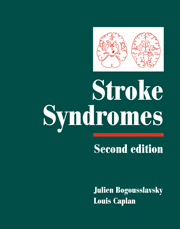Book contents
- Frontmatter
- Contents
- List of contributors
- Preface
- PART I CLINICAL MANIFESTATIONS
- 1 Stroke onset and courses
- 2 Clinical types of transient ischemic attacks
- 3 Hemiparesis and other types of motor weakness
- 4 Sensory abnormality
- 5 Cerebellar ataxia
- 6 Headache: stroke symptoms and signs
- 7 Eye movement abnormalities
- 8 Cerebral visual dysfunction
- 9 Visual symptoms (eye)
- 10 Vestibular syndromes and vertigo
- 11 Auditory disorders in stroke
- 12 Abnormal movements
- 13 Seizures and stroke
- 14 Disturbances of consciousness and sleep–wake functions
- 15 Aphasia and stroke
- 16 Agitation and delirium
- 17 Frontal lobe stroke syndromes
- 18 Memory loss
- 19 Neurobehavioural aspects of deep hemisphere stroke
- 20 Right hemisphere syndromes
- 21 Poststroke dementia
- 22 Disorders of mood behaviour
- 23 Agnosias, apraxias and callosal disconnection syndromes
- 24 Muscle, peripheral nerve and autonomic changes
- 25 Dysarthria
- 26 Dysphagia and aspiration syndromes
- 27 Respiratory dysfunction
- 28 Clinical aspects and correlates of stroke recovery
- PART II VASCULAR TOPOGRAPHIC SYNDROMES
- Index
- Plate section
20 - Right hemisphere syndromes
from PART I - CLINICAL MANIFESTATIONS
Published online by Cambridge University Press: 17 May 2010
- Frontmatter
- Contents
- List of contributors
- Preface
- PART I CLINICAL MANIFESTATIONS
- 1 Stroke onset and courses
- 2 Clinical types of transient ischemic attacks
- 3 Hemiparesis and other types of motor weakness
- 4 Sensory abnormality
- 5 Cerebellar ataxia
- 6 Headache: stroke symptoms and signs
- 7 Eye movement abnormalities
- 8 Cerebral visual dysfunction
- 9 Visual symptoms (eye)
- 10 Vestibular syndromes and vertigo
- 11 Auditory disorders in stroke
- 12 Abnormal movements
- 13 Seizures and stroke
- 14 Disturbances of consciousness and sleep–wake functions
- 15 Aphasia and stroke
- 16 Agitation and delirium
- 17 Frontal lobe stroke syndromes
- 18 Memory loss
- 19 Neurobehavioural aspects of deep hemisphere stroke
- 20 Right hemisphere syndromes
- 21 Poststroke dementia
- 22 Disorders of mood behaviour
- 23 Agnosias, apraxias and callosal disconnection syndromes
- 24 Muscle, peripheral nerve and autonomic changes
- 25 Dysarthria
- 26 Dysphagia and aspiration syndromes
- 27 Respiratory dysfunction
- 28 Clinical aspects and correlates of stroke recovery
- PART II VASCULAR TOPOGRAPHIC SYNDROMES
- Index
- Plate section
Summary
Delimiting the field
Right hemisphere lesions are often associated with a number of specific syndromes, such as left hemineglect, topographical disorientation, anosognosia, visual agnosias and visuo-spatial deficits. Unlike the left hemisphere syndromes of aphasia and apraxia, none of the right hemisphere syndromes possesses a simple and clinically relevant model derived from human observations. The rare models that we have and that are gaining importance in rehabilitation, concern visual agnosias, visuo-spatial deficits or hemineglect and rely on experimental data from non-human primates.
Clinical observations and experimental studies of the past 30 years show that the field of right hemisphere syndromes is far more complex than originally believed (Table 20.1). Although some of the syndromes have been repeatedly reported following right unilateral lesions, other syndromes can occur after right or left unilateral lesions, but do so more often after right than left lesions. For other syndromes the right hemispheric lesion is necessary, but not sufficient; these syndromes occur invariably after bilateral lesions, but never after unilateral left lesions. This chapter concentrates on syndromes for which right hemispheric involvement is necessary or which have been classically associated with right hemisphere damage.
Hemineglect
Hemineglect is characterized by lack or decrease of attention to stimuli and events on the left-hand side of the patient following a right hemispheric lesion. In extreme cases, patients do not react when they are spoken to from the left side, do not eat food on the left half of their plate, do not shave or make up the left half of their face or read the left side of their newspaper.
- Type
- Chapter
- Information
- Stroke Syndromes , pp. 264 - 272Publisher: Cambridge University PressPrint publication year: 2001
- 2
- Cited by

